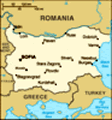Advertisement
3
rd to 7
thJune
Kromodovo near Melnik, Bulgaria
Before we left Greece we stocked up with food (mainly Kalamata olives) and filled up with petrol and headed north towards the Bulgarian border. It’s the first time we have had to stop at a border and show passports. We then had to find somewhere that sold a vignette allowing us to drive on Bulgarian roads. The road is the main artery connecting Romania, Bulgaria and Greece so is used by huge freight lorries which seemed to have parked up haphazardly just past border control. We pulled up behind one lorry at a wooden hut type building that looked like it sold vignettes but on discovering it didn’t, the lorry pulled away catching the roof and edge of the cabin with its trailed and shaking the whole thing with some force. It was a lucky the hut was empty. We eventually negotiated our way through, found the vignette seller (who looked a bit dodgy to me) and were eventually on our way to Camping Kromodovo about thirty minutes away. The campsite is small and perfectly formed. John and Sara (from Manchester) have been living in Bulgaria for the
last four years. They have renovated the property and last year opened their garden as an eco-campsite. It’s lovely and small enough that everyone talks to everyone else. We had our neighbour Tony (from Glasgow originally but currently residing in Inverness) round for tea last night. On our last night there, he brought out his telescope and showed us the moon and Jupiter. It was amazing. We could see the sun glinting off distant mountains on the moon creating tiny diamonds of light beyond the dark edges. We could also see two of Jupiter’s moons and two of its rings. Tony, as well as being an amateur astrologist is also a keen bird watcher and pointed out a pigmy owl perched on the telegraph wires.
The area is renowned for its wine making and vineyards. Melnik, just 11 kms up the road and described as Bulgaria’s smallest town was once the mecca for wine traders from all over the continent, particularly in the late 18
th and early 19
th century known as the Bulgarian national revival period. Many of its buildings date from this time and one, the Kardopulov House built in 1754 was home to one of
Melnik’s predominant wine merchants. It has been beautifully preserved and open to the public. Under the house and tunnelled into the rock is a labyrinth of 180 metres of tunnels where the wine was stored. The area is prospering again with regard to wine making and several new wineries have been built in the last few years. We visited the Villa Melnik winery where the owner’s son gave us a tour including the cellar which is dug out of the sandy hillside ensuring the temperature remains constant all year round. Then we sampled the wines. The Mediterranean sunny climate means that the grapes have a high sugar content which make wines of around 14% proof. The local grape is the broad leaf Melnik and Melnik 55 is a popular wine made from the grape. The winery also grew a number of other varieties and John particularly liked the cabinet sauvignon. We were on our bikes the day we had the tour and tasting but made sure we passed again in the van to buy a couple of boxes.
The town of Melnik is really just one street with lots of restaurants and shops selling mainly wine, bottled
fruit and local honey . The area is also known for its sand / clay geology that has been eroded by the rain and wind over the years to form huge pyramid type formations. We did a couple of walks from the town, one to St George Victorious Church near the village of Zlatolist (population of 10). The church was built in the 1800’s and from the outside looks unimpressive. Once in the walls of the grounds you enter through a small door (about four foot high) and descend steps into the main body of the church, its walls covered in remarkable murals painted in 1876. In the middle of the dome there is a marble plaque with double-headed eagle. Legends have it that if a person steps on it, they will be cured from any disease. In the churchyard there is a plane around 1300 year old, which is also believed to help for various diseases. During the first half of the twentieth century in a little room in the female ward lived Reverend Stoyna, revered by the local population because for her healing and prophetic powers. Her life passed in caring for people, in fasting and prayers. Unfortunately
we didn’t know about all of this until I read up about the place later. We hadn’t really planned to do the walk we did, we just got lost on the way to the Rozen Monastery!
The second walk we did was to the monastery after finding the right path (which was signposted). The walk takes you up a dried up river bed and then up over the valley side. The views of the sand pyramids are exceptional. The monastery was very peaceful (until a school party arrived) and its church richly decorated.
We have eaten out a couple of times. So far I am impressed with the food. For lunch one day I had Mish Mash which is essentially a big bowl of scrambled eggs, peppers, tomatoes and grated cheese – it was delicious and very cheap!
Advertisement
Tot: 0.099s; Tpl: 0.011s; cc: 10; qc: 53; dbt: 0.0533s; 1; m:domysql w:travelblog (10.17.0.13); sld: 1;
; mem: 1.2mb







